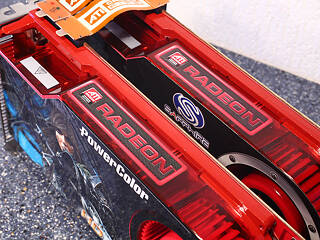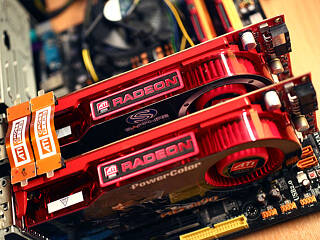 159
159
AMD Radeon HD 4890 CrossFire Review
(159 Comments) »Introduction

Today AMD announced their Radeon HD 4890 Series. It is based on the RV790 GPU which is an improved version of the RV770. The major cornerstone specifications have remained the same, only improvements related to clock frequencies have been made. While it was almost impossible to get an RV770 to run far beyond 800 MHz, the ATI HD 4890 reference runs at 850 MHz core by default. Many partners will be offering overclocked boards as well ranging up to 1000 MHz core speed.
Since we managed to acquire two HD 4890 samples for our testing, we decided to bring you a multi-GPU performance review for the first time.
HD 4890 CrossFire is available on any AMD or Intel chipset motherboard that has two PCI-Express slots. After installing the cards you need to put both CrossFire bridges across the CF connectors, hook up the power and you are ready to go.
Once the drivers are up and running, you will be greeted by a message from ATI's Catalyst Control Center, that a CrossFire compatible configuration has been detected and that it would be best if you enabled CrossFire. This whole process is remarkably easy and even less experienced users will be able to do it. In case there is a problem CCC will notify you and present possible solutions.
Test System
| Test System | |
|---|---|
| CPU: | Intel Core i7 920 @ 3.8 GHz (Bloomfield, 8192 KB Cache) |
| Motherboard: | Gigabyte X58 Extreme Intel X58 Kindly supplied by Gigabyte |
| Memory: | 2x 1024MB OCZ DDR3 Platinum @ 1140 MHz 6-6-6-19 |
| Harddisk: | WD Raptor 740ADFD 74 GB |
| Power Supply: | BFG ES-800 800W |
| Software: | Windows Vista SP1 |
| Drivers: | NVIDIA: ForceWare 181.20, GTS 250: 182.06, GTX 275: 185.63 ATI: Catalyst 9.1, HD 4890: 8.592.1 |
- All video card results were obtained on this exact system with the exact same configuration.
- All games were set to their highest quality setting
- 1024 x 768, No Anti-aliasing, No anisotropic filtering. This is a standard resolution without demanding display settings.
- 1280 x 1024, 2x Anti-aliasing, 8x anisotropic filtering. Common resolution for most smaller flatscreens today (17" - 19"). A bit of eye candy turned on in the drivers.
- 1680 x 1050, 4x Anti-aliasing, 16x anisotropic filter. Most common widescreen resolution on larger displays (19" - 22"). Very good looking driver graphics settings.
- 1920 x 1200, 4x Anti-aliasing, 16x anisotropic filter. Typical widescreen resolution for large displays (22" - 26"). Very good looking driver graphics settings.
Call of Duty 4

Call of Duty 4 is a first-person shooter that is built on the award winning Call of Duty Series. It is the first version to play in modern times. In a near-future conflict between the United States, Europe and Russia you get to play as a United States Marine and a British SAS operative. The engine is Infinity Ward's own creation and has true dynamic lighting, depth of field, dynamic shadows and HDR. Even though the game plot is scripted you will find yourself in intense battles, often working together with computer controlled team mates.




Our Patreon Silver Supporters can read articles in single-page format.
Apr 24th, 2024 13:54 EDT
change timezone
Latest GPU Drivers
New Forum Posts
- Aida64 cache mem OC (6)
- Official Board Game Discussion (20)
- Rare GPUs / Unreleased GPUs (1873)
- !BEWARE! ASRock B650E Steel Legend CPU Destroying Bios BUG! (60)
- How are MX330 and İ5 1135G7 ? (5)
- need help with motherboard/ ram compability certainty (16)
- Which new games will you be buying? (312)
- Meta Horizon OS (11)
- 2022-X58/1366 PIN Motherboards NVME M.2 SSD BIOS MOD Collection (655)
- The TPU UK Clubhouse (24781)
Popular Reviews
- Fractal Design Terra Review
- Thermalright Phantom Spirit 120 EVO Review
- Corsair 2000D Airflow Review
- Minisforum EliteMini UM780 XTX (AMD Ryzen 7 7840HS) Review
- ASUS GeForce RTX 4090 STRIX OC Review
- NVIDIA GeForce RTX 4090 Founders Edition Review - Impressive Performance
- ASUS GeForce RTX 4090 Matrix Platinum Review - The RTX 4090 Ti
- MSI GeForce RTX 4090 Suprim X Review
- MSI GeForce RTX 4090 Gaming X Trio Review
- Gigabyte GeForce RTX 4090 Gaming OC Review
Controversial News Posts
- Sony PlayStation 5 Pro Specifications Confirmed, Console Arrives Before Holidays (116)
- NVIDIA Points Intel Raptor Lake CPU Users to Get Help from Intel Amid System Instability Issues (106)
- AMD "Strix Halo" Zen 5 Mobile Processor Pictured: Chiplet-based, Uses 256-bit LPDDR5X (101)
- US Government Wants Nuclear Plants to Offload AI Data Center Expansion (98)
- Windows 10 Security Updates to Cost $61 After 2025, $427 by 2028 (84)
- Developers of Outpost Infinity Siege Recommend Underclocking i9-13900K and i9-14900K for Stability on Machines with RTX 4090 (84)
- TechPowerUp Hiring: Reviewers Wanted for Motherboards, Laptops, Gaming Handhelds and Prebuilt Desktops (78)
- Intel Realizes the Only Way to Save x86 is to Democratize it, Reopens x86 IP Licensing (70)

